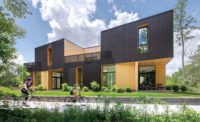One Hundred Mill Avenue, Hayden's Flour Mill
Tempe Nods to Past and Eyes the Future.

One Hundred Mill Avenue
One Hundred Mill Avenue, designed by Davis, consists of three towers on Mill Avenue, the main thoroughfare in downtown Tempe, Arizona.
Image courtesy Davis

One Hundred Mill Avenue
Built in the 1870s, La Casa Vieja is the city's oldest continuously occupied building. Since the 1950s it has been home to Monti's restaurant, which will continue to operate after the completion of One Hundred Mill Avenue.
Photo courtesy 3W Companies

Hayden's Flour Mill
Across Mill Avenue is Hayden's Flour Mill. Meyer, Scherer & Rockcastle and Substance Design Consortium have designed an adaptive reuse of the historic complex.
Image courtesy Avenue Communities

Hayden's Flour Mill
An archeological garden, flanked by a café, will reveal portions of an old canal that fed the mill with water from the nearby Salt River (now Tempe Town Lake).
Photo courtesy Avenue Communities

Hayden's Flour Mill
A historic view of the mill waste race.
Photo courtesy Avenue Communities












